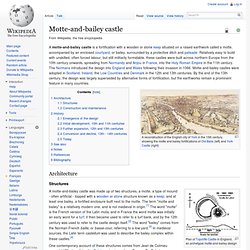

Motte and Bailey Castles. Motte and bailey castles appeared in England after the Norman Conquest of 1066.

Motte and bailey castles were a common feature in England by the death of William the Conqueror in 1087. Their construction was the start of what was to become a massive castle building programme in England and Wales. When William landed at Pevensey in 1066, he immediately set about building a castle to protect himself and his most important men.
William was a highly skilled and feared soldier who had learned his military skills in northern France. The Normans achieved great fame for their castle building. Motte and Bailey Castles. A motte-and-bailey castle is a fortification with a wooden or stone keep situated on a raised earthwork called a motte, accompanied by an enclosed courtyard, or bailey, surrounded by a protective ditch and palisade.

Relatively easy to build with unskilled, often forced labour, but still militarily formidable, these castles were built across northern Europe from the 10th century onwards, spreading from Normandy and Anjou in France, into the Holy Roman Empire in the 11th century. The Normans introduced the design into England and Wales following their invasion in 1066. Motte-and-bailey castles were adopted in Scotland, Ireland, the Low Countries and Denmark in the 12th and 13th centuries. By the end of the 13th century, the design was largely superseded by alternative forms of fortification, but the earthworks remain a prominent feature in many countries. Motte and Bailey Castles.